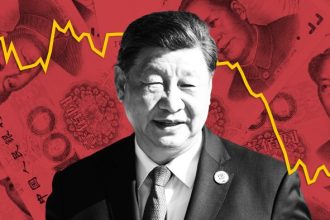After battling persistent deflation for three decades, Japan is now bracing for a different kind of fight: inflation.
The coming sea change has big implications for Japan’s economy and for investors—and lessons for the rest of the world. Inflation will have a major impact on Japanese companies, lifting many of their values as they become more profitable. Even after strong recent gains in stocks, it’s not too late for investors to benefit from a rising inflationary tide.
Overall consumer prices have barely changed in Japan since the early 1990s. Japan’s inflation rate ranged from a low of negative 1.35% to a high of 2.76% from 1995 to 2022. Consumer prices fell on an annual basis in 15 of those 28 years.
Many saw Japan’s inability to generate consistent, predictable price gains as an example of a central bank policy failure. The world’s third-biggest economy has seen 30 years of relative economic decline. Deflation discouraged spending and investment. Why buy or invest in something when there’s a good chance it will be cheaper in the future?
The Bank of Japan
tried everything it could to revive inflation. It was the first major central bank to buy government bonds to suppress yields, and the first to embrace negative interest rates. Even in June, as nearly all major economies except China were raising interest rates, Japan kept its ultraloose policy unchanged, and continued to target bond yields to ensure that rates stayed extremely low.
Policy makers in Japan have been fighting powerful demographic pressures that kept inflation—even relatively moderate inflation—from taking hold. But that is starting to change as workers age and leave the labor market, squeezing the supply of goods and services the economy can provide while demand stays more or less the same. Prices have been rising faster than the BOJ’s 2% target. The annual rate was 3.2% in May, and is expected to average about 2.5% this year, which means the inflation battle is now on.
Inflation is a welcome change for Japanese companies that have struggled to increase prices for decades. And it’s a good thing for markets and the broader economy because it spurs growth.
Meanwhile, Japan isn’t alone. No other major country has suffered from deflation in quite the same way as Japan, but others are beginning to confront the challenges of aging populations: Italy, Germany, China, even the United States, which is coping with an aging baby boom generation. At some point, they all could all see the size of the workforce decline as a proportion of their overall population, which creates inflationary pressure.
Small doses of inflation, on the other hand, can be beneficial for companies because it encourages investment and provides flexibility in adjusting to higher input costs like energy or commodities. Japan’s stock market has already seen a record 30% gain so far this year, and the rally could go higher. Optimism about earnings and productivity have bolstered sentiment. Another sign of optimism:
Warren Buffett’s Berkshire Hathaway
this year increased stakes in Japan’s five biggest trading companies that sit at the heart of its economy.
“Now the Japanese government, the general public, and corporations are all ready to change,” says Naruhisa Nakagawa, chief investment officer at Caygan Capital. “This could be a once-in-a-decade opportunity to buy Japanese stocks.”
Investors seeking to play rising inflation in Japan could buy shares of consumer stocks. Or they could mimic Buffett, with his large stakes in
Itochu
(ticker: 8001.Japan),
Marubeni
(8002.Japan),
Mitsubishi
(8058.Japan),
Mitsui
(8031.Japan), and
Sumitomo
(8053.Japan). A broad exchange-traded fund of Japan shares could also work, such as the
iShares MSCI Japan
(EWJ) or the
WisdomTree Japan Hedged Equity Fund
(DXJ).
While Japan’s deflation experience began decades ago, other countries have begun to wrestle with the implications of declining birth rates and aging populations. The dynamic, driven by demographic change, is complex. Early on, an aging population creates a trend in which the ratio of workers to nonworkers—mostly children and retired people—grows. More workers and fewer nonworkers drive economic output even as consumer demand stays roughly the same or even falls. This stifles inflationary tendencies.
Japan is famous for its bluefin tuna used in sashimi and sushi—and for its huge fishing fleets. This first phase would be as if the number of fishermen in Japan kept growing, while demand from buyers of fish remains stable. Fish prices would fall.
But at some point as the aging process continues, many of those workers either retire or die, and the birth rate isn’t high enough to fully replace them. Japan tried to adjust by hiring more women and delaying retirements. But the population peaked, and began falling, a decade ago. To stretch the fish metaphor, the number of fishermen began to fall, while the demand for tuna remained steady, or at least fell at a slower pace.
That’s when demographics shift began to push prices up rather than down. The greater ratio of dependents to workers should trigger higher inflation, and faster wage growth. Fewer workers mean that companies have to become more efficient and productive. Higher productivity means faster growth.
It’s not difficult to imagine that aging populations could soon become an additional inflationary force in much of the world. It’s another tailwind for inflation that has picked up dramatically since the global economy emerged from Covid-19 and Russia’s invasion of Ukraine.
Given its history, the Bank of Japan is aware of this dynamic , though it’s also sensitive to charges that it raised interest rates too early in the 1990s and 2000s. Kazuo Ueda, the central bank governor since April, has kept a steady hand so far. Still, Apollo Global Management Chief Economist Torsten Sløk reckons that the BoJ will abandon efforts to control longer-term bond yields later this year.
And there are voices warning about building inflationary pressures. “The BOJ is way behind the curve” and should be tightening now, says Caygan’s Nakagawa. “It’s too dangerous to keep monetary policy too accommodative.”
To be sure, the BOJ isn’t alone in thinking that the shift to higher inflation won’t happen quickly. Gurpreet Gill, a macro strategist at Goldman Sachs Asset Management agrees, noting how uncertain the timing is. There are also offsetting factors, such as improvements in productivity, that could keep a lid on price increases and stop the BOJ from tightening policy to excess.
Nevertheless, Japan is a prime example of how differently the economic phenomenon of inflation is being viewed from just a few years ago. “There’s a growing recognition that we have come out of the pandemic with a changed environment,” says Goldman’s Gill. “The world is getting more uncertain and complex.”
Write to Brian Swint at [email protected]
Read the full article here





